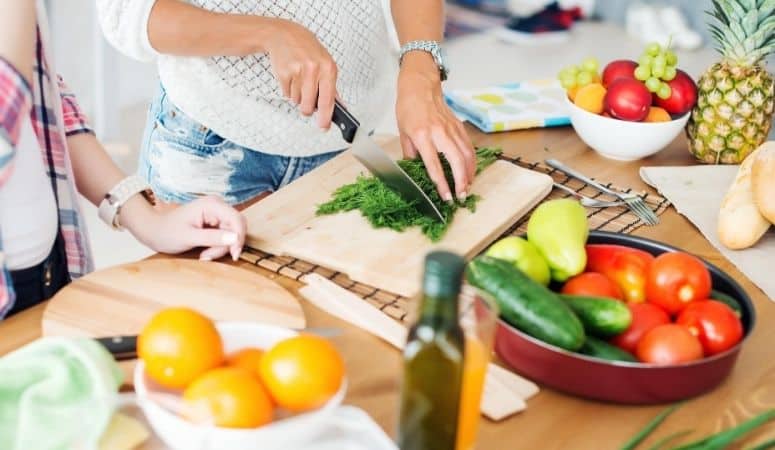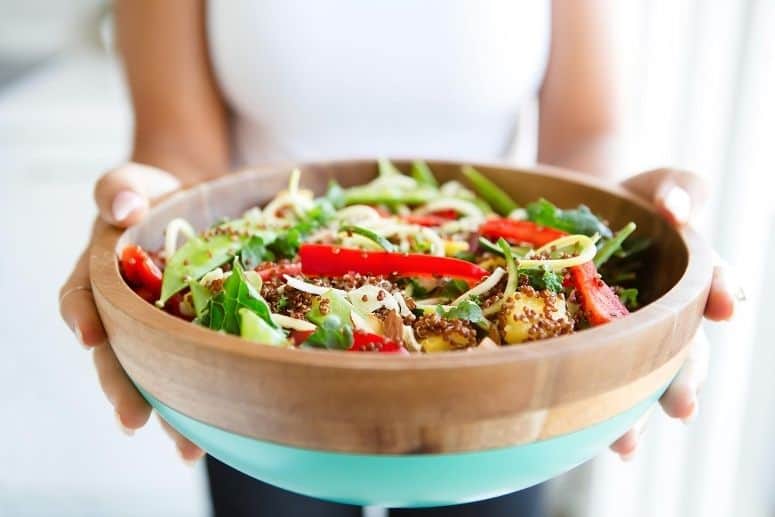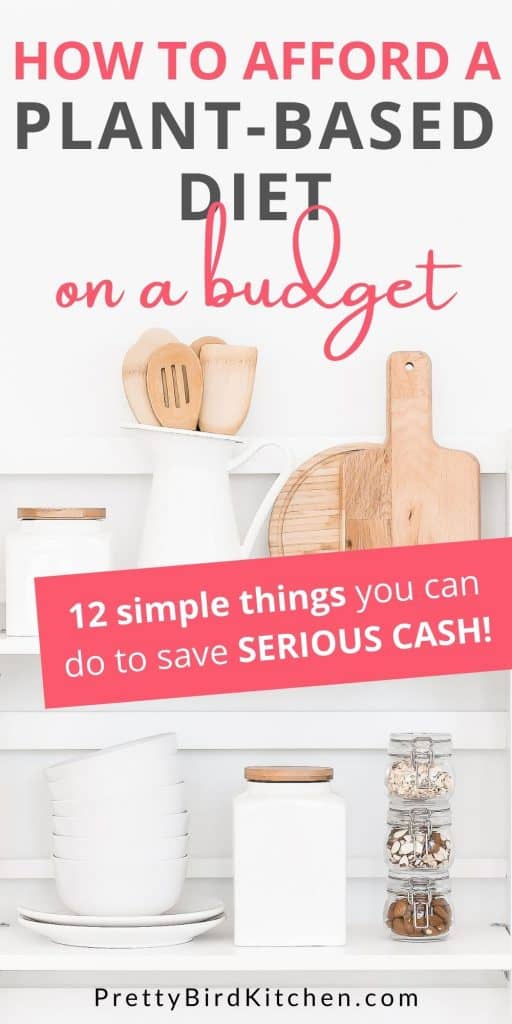How to Afford a Plant-Based Diet on a Budget
Think your budget is too tight to eat plant-based? Well, think again! Here’s how you can afford a plant-based diet on a budget, even if you think healthy food is too expensive.

This post may contain affiliate links. See my full disclosure here.
Disclaimer: I am not a nutritionist or a healthcare professional. You can read about our personal experience with a plant-based diet, but please know that your experience may be different from ours. You should do your own research before making any changes to your diet or lifestyle especially if you have a health condition.
“I can’t afford to eat plant-based.”
“It costs more to buy healthy food than junk food.”
“I’ll make my health a priority when I can afford it.”
“Plant-based diet on a budget? I think not.”
Have you ever said those things, either to yourself or out loud?
I’ve heard these excuses plenty of times, sometimes from my own mouth! But I think there’s a huge misconception surrounding healthy food options, especially when it comes to buying whole plant foods.
In fact, when Josh and I started eating a more plant-based diet, I was surprised to learn just how affordable healthy food can be. Believe it or not, we actually spend less money eating this way than we ever did on the Standard American Diet!
So I’m here to challenge all those excuses you’ve ever heard or said. You can most definitely afford to eat a whole food, plant-based diet on a budget. You just have to know how to do it the right way.
Let me share with you what I’ve learned so you can get the biggest bang for your buck at the grocery store.
How to save money on a plant-based diet
Here are 12 tips to help you save money on a plant-based diet.

1. Shop at discount grocery stores
Discount grocery stores such as Aldi or Lidl can help you save a ton of money on groceries. These stores mainly carry their own house brands of food along with a very limited assortment of name brands items.
But don’t let the discount label fool you! Cheaper does NOT equal lower quality at these stores. In fact, I think food from Aldi and Lidl is just as good as the name brand stuff you’d find at a regular grocery store.
Related: 26 Affordable Plant-Based Foods to Buy at ALDI
Related: What to Expect From Lidl: My First Trip to Aldi’s Competitor
2. Buy store brands
If you don’t have an Aldi or Lidl near you, buy the store brands at your favorite grocery store. You might not save quite as much as you would at a discount grocery store, but you’ll still likely pay less than you would for the name brand.
And if you’re worried about the food tasting bad or not like what you’re used to, then just try a few store brand items at a time to see how the quality stands up. Some may not taste as good, but you might be surprised that you can’t even tell the difference between the store brand and the name brand!
If you can make even a few swaps to store brands, then you’ll still see a lower bill at checkout.

3. DIY everything
Pre-made food can really rack up your grocery bill. Even simple things like almond milk, applesauce, and canned beans are already made for you, so if you can spend a little time making these yourself, then you’ll save some serious cash on groceries!
You can make your own almond milk with my recipe here.
4. Buy in bulk when practical
Sometimes you can get a better deal on food when you buy it in bulk from a wholesale club like Costco, BJ’s, or Sam’s Club.
But it helps to do a little price comparison first. For example, I found out that I can get a better deal on maple syrup and almonds at Sam’s Club than I can at Aldi, but carrots are still cheaper at Aldi even though they aren’t sold in bulk.
Also consider the life span of the food you’re buying in bulk. Can you really eat five heads of romaine lettuce before it goes bad?
Do what works best for you and your family size.

5. Stick to cheap basics
When you have a limited budget to work with, make sure most of your meals revolve around cheap basics. Things like rice, beans, potatoes, oatmeal, and bananas are some of the cheapest ingredients you can find at the grocery store!
6. Buy seasonal produce
Round out the rest of your grocery list with seasonal produce. You’ll pay less for in-season produce than you would for out-of-season produce, so try to buy what’s in season when you can.
I have an entire Pinterest board dedicated to seasonal produce guides that you might find helpful!
7. Make a meal plan and grocery list
I’m a huge fan of meal planning because it helps you avoid impulse buys at the grocery store. When you plan out your weekly menu and grocery list, you only buy the food you need for this week’s meals. No more, no less. (Well, assuming you don’t succumb to those impulse buys!)
Also, when you have a plan for the food you buy, you don’t waste as much food. Do you ever buy food only to have it go bad in your refrigerator? Think of those rotten strawberries as dollar bills when you throw them in the trash.
Instead of wasting food because you bought more than you really needed, shop with a plan so you get the biggest bang for your buck.
If you’re new to meal planning, then you should definitely read my in-depth meal planning article. It will start you off right!
8. Build your menu around sale items and food you already have at home
When you make your meal plan, choose meals that incorporate food that’s on sale. Better yet, try to use up the food you already have in your kitchen!

9. Buy organic where it matters, but only if you can afford it
You don’t need to buy all of your food organic, especially if you’re working with a limited grocery budget. Instead, buy organic where it matters, and only if you can afford to do so.
I like to reference the Dirty Dozen and Clean Fifteen when I can’t decide if I should buy organic or not. The Dirty Dozen is a list of foods that have higher pesticide residues. If you can afford it, it’s best to buy these foods organic. The Clean Fifteen is a list of foods that have lower pesticide residues. These are okay to buy non-organic.
You can read more about the Dirty Dozen and Clean Fifteen here.
Do what makes sense for you and your budget. If you can’t afford any organic produce, that’s okay! You’re still getting better quality nutrition than if you were buying prepackaged Standard American Diet meals.
As your grocery budget increases, incorporate more organic produce as you see fit.
10. Limit your use of expensive ingredients
Eating a plant-based diet can be as cheap or expensive as you want. Some of the more expensive ingredients include maple syrup, dates, certain nuts and seeds, and even some produce!
You don’t need to use an abundance of these ingredients, especially when you have limited funds to work with. Instead, stick to the cheap staples like we talked about earlier and save the more expensive ingredients for occasional meals.

11. Buy frozen fruits and veggies
Frozen fruits and vegetables are just as healthy as fresh produce. It’s true! Frozen produce is flash-frozen so all the nutrients are left intact.
Don’t feel like you always have to buy fresh produce on your whole food, plant-based diet. Frozen fruit and veggies are just as healthy, and they’re often much cheaper.
12. Stay away from processed vegan junk food
A quick way to run up your grocery bill is by buying processed vegan junk food and faux meat and dairy alternatives.
You don’t need these foods in your diet, and they aren’t healthy despite what the packaging may claim. You’re better off leaving them on the grocery store shelves or only buying them on occasion.
Is eating a plant-based diet cheaper?
You may be wondering if eating a plant-based diet is cheaper than eating the Standard American Diet.
In my experience, yes!
Because we aren’t buying expensive meat, dairy products, and processed foods anymore, we save so much money on our grocery bill each month.
I do have some weeks where I spend a little more on bulk items like nuts and whole grains, but for the most part, I just fill up my shopping cart with cheap produce. I’m always amazed when I get to the checkout and have a cart full of produce and a bill totaling only $35-50!
Sticking to whole plant staples and avoiding processed junk is how people afford plant-based diets.
Final Thoughts on Eating Plant-Based on a budget
You can definitely eat a whole food, plant-based diet even if you’re on a budget. In fact, I think this lifestyle is the cheapest one out there because it relies so heavily on cheap staples!
All you really need are basics like rice, beans, and potatoes along with some fresh seasonal produce or a few bags of frozen fruit and veggies. Truly, it doesn’t get much cheaper than that!
Other Plant-Based Articles You May Enjoy
- Plant-Based Shopping List: What to Buy When You Follow a Plant-based Diet
- Plant-Based vs. Vegan: The Major Differences You Need to Know About
- The Meal Planning Binder You Need to Make Meal Planning a Breeze

Want to remember this? Save it to your favorite Pinterest board by clicking the images below!



